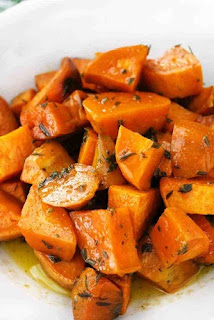Anti-inflammatory foods
Students in my class are interested in anti-inflammatory
foods as many work out and are interested in reducing inflammation. Others are interested in diets to reduce
inflammation for those with colitis or IBD.
Older students are interesting in anti-inflammatory diets to control
osteoarthritis. Rather than just taking
drugs to reduce inflammation, are there anti-inflammatory foods?
What are the foods one can eat to reduce inflammation
and what conditions do anti-inflammatory diets help?
Osteoarthritis – a
common form of arthritis people experience as they age. The cartilage in our joints begins to break
down which results in swelling, stiffness, and pain in the joints. The U.S. News & World Report has many
interesting articles on diet with a recent one titled, “Osteoarthritis
Diet: Foods to Eat and Avoid”. According to the registered dietitian,
Daniela Novotny, from Missouri State University, the foods we eat can increase
or decrease inflammation. What are the
foods to eat on an Osteoarthritis Diet to reduce inflammation?
a.
Fruits and Vegetables – all those
antioxidants in fruits and vegetables help fight off inflammation. Each color in fruits and vegetables provides
different antioxidants so eating many colors is a good thing. Some fruits and vegetables provide
antioxidants that are particularly helpful in reducing inflammation including:
- Citrus fruits – enjoy that glass of 100% juice, some oranges, some grapefruit.
- Pumpkin – who knew that eating some pumpkin pie would be good for your joints?
- Berries – blueberries are often considered a super food because of their beneficial health effects. But other berries provide anti-inflammatory effects including raspberries and strawberries.
- Sweet Potatoes – eat some extra sweet potatoes during the holidays to help reduce inflammation
- Carrots – munch on some baby carrots and bring some in your lunch.
- Cabbage – enjoy some coleslaw or cooked cabbage.
 |
| Maple and Rosemary Glazed Sweet Potatoes |
b.
Omega-3 fats – many people are still
unaware that there are good fats and not so good fats. The Omega-3 fats are good for your heart and
good for your joints. Football players
often add some omega-3 fats to their day in the form of flaxseed, chia seed or
walnuts to help reduce inflammation. I
add some chopped walnuts to my oatmeal.
Fatty fish like salmon or tuna also provide the healthy Omega-3
fats. So, enjoy that tuna fish sandwich
at lunch.
c.
Nuts – as noted above, walnuts are a good
source of the healthy Omega-3 fats. Nuts
also are good sources of magnesium, fiber and vitamin E.
d.
Extra Virgin Olive Oil (EVVO) - use it in cooking, sautéing
vegetables. EVVO has a special fat in it
called, oleocanthal, which seems to have more inflammatory powers than other
fats. Another source of
anti-inflammatory fats are avocados so enjoy that guacamole.
e.
Garlic and onions – one of my daughters
loves to cook with garlic. Once a roofer
working on our home was on break. He
reached into his pocket and pulled out a whole garlic. He peeled it and ate the whole thing. He said he often ate garlic as a snack. Good for his heart and good for his joints.
f.
Turmeric
– not really a “food” but a spice one adds to food and is often used in
Asian cooking. But turmeric has renewed
interest as having some natural anti-inflammatory compounds called
curcuminoids. One can eat turmeric in
foods like curry or chutney. Others buy it in pill form. The Mayo Clinic has a one-minute video
on the health benefits of turmeric. Mayo
Clinic does caution
those taking supplements should check with their doctor about any interaction
with medications.
 |
| Turmeric - an anti-inflammatory spice |
What foods to avoid if you want to reduce
inflammation?
1.
Saturated fats – these are the not so
good fats in our diet. These fats
increase our risk of heart disease and can lead to increased inflammation in
our joints. Think of fat that is solid
at room temperature like the fat in bacon grease. The marbling you see in meat is saturated
fat. Choose leaner cuts of meat, leaner hamburger, cut off the fat rind from a
pork chop (after you cook it as the fat adds flavor).
2.
Added sugars – so much confusion about
sugars in our foods. Added sugars, as
the name implies, are sugars manufacturers add to our foods like the high
fructose corn syrup added to a can of Coke.
Or the added sugars in fake juice drinks like Sunny D. These are not the natural sugars in foods
like the fructose in a banana or in orange juice. Researchers have found that
foods with added
sugars have a “compound called cytokines, which stimulate inflammation”.
3.
Refined carbs – those that manufacturers
have taken out most of the nutrients like white bread, white rice. Eating refined foods like foods made with
white flour or eating white rice actually help our bodies produce substances
that lead to inflammation. On the other
hand, whole grains like oatmeal, whole grain bread, brown rice, Quinoa are
foods we want in our diet.
What changes can you make in your diet to fight
inflammation? Choosing 5 A Day – or five
fruits and vegetables a day is a good place to start. Add some oatmeal to your morning routine. Sprinkle some walnuts on your cereal or
salad. Bring some baby carrots with you
as a snack. Simple changes one makes in
their daily eating can have huge health benefits.
 |
Spiced walnut snack box
|
Sources: Osteoarthritis
Diet: Foods to Eat and Avoid, Turmeric,
video,
caution
, added, Image sources: Turmeric, Sweet Potatoes, box



Comments
Post a Comment